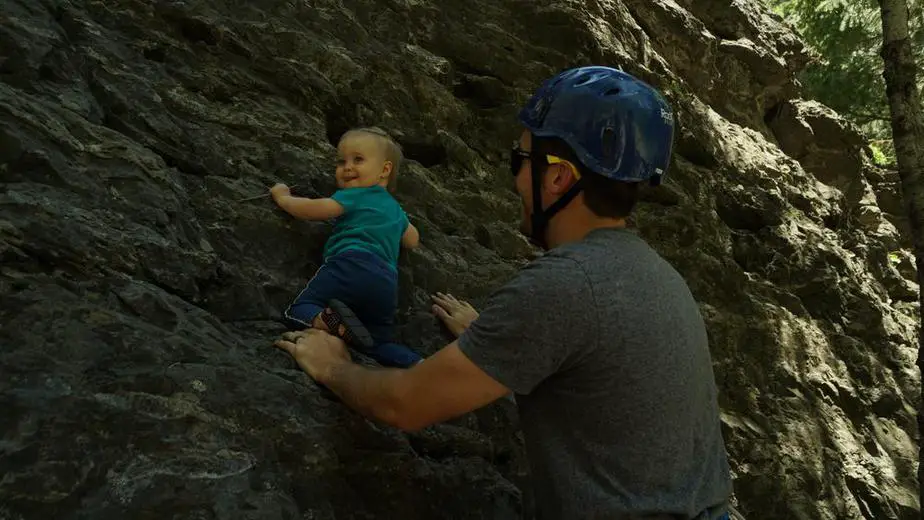Having kids doesn’t mean the end of climbing, it just means your climbing trips need to be fine tuned and more planned and deliberate. Full days and overnighters turn into half days, and you have to pack more fruit snacks than you are used to.
Kids can start climbing at a young age- my first trip was at age 4. It’s a great activity that keeps them happy, outside, and confident in themselves. Here are some tips and tricks for taking kids of any age climbing.
10 Tips for Climbing and Bouldering with Kids:
- Safety First
- Choose a Kid-Friendly Crag
- Don’t Go Alone
- Lower Your Expectations
- Pack Enough Toys, Snacks, (And Diapers!)
- Stick to Single Pitch or Bouldering
- Have a Backup Plan
- Get the Right Climbing Gear for Kids
- Be Prepared for Anything
- Temper your Personal Ambitions
Safety First
We all know that rock climbing has a reputation for being dangerous (whether deserved or not ). Over time we pick up skills and best practices to keep ourselves safe. Set up an area for the kids to play that is relatively flat and free of tripping hazards that is far enough away from the wall to avoid any rockfall or someone accidentally dropping gear.
). Over time we pick up skills and best practices to keep ourselves safe. Set up an area for the kids to play that is relatively flat and free of tripping hazards that is far enough away from the wall to avoid any rockfall or someone accidentally dropping gear.
Get used to always wearing helmets, and have the kids wear helmets if they’re going to be around the wall at all. The belayer needs to stay focused on the climber, no matter what kind of raucous is happening around. Don’t belay with a baby in your backpack, as tempting as that may sound.
Choose a Kid-friendly Crag
A two-hour hike up a steep scree field to a narrow belay area is not the best place to have kids running around. Look for a climbing area with enough flat open space nearby so that kids can play without you being worried about them falling or getting into trouble. Keep an eye out for ants or bees nests as well. Try to find a spot that will stay out of the sun.
In my experience, people are usually pretty accommodating of #cragbabies and kids, but feel out the local vibe. Ask around at your gym to see where people usually take their kids.
There’s really no route too easy for kids to climb. It can be good to start them on a less-than-vertical class 4 or 5 slope so that they get the feeling of ascending without needing to overcome their natural fear of heights.
Climbing gyms usually have a couple of areas designated for beginners and kids with big holds on almost every t-nut. This can be a good place to practice before going outdoors for the first time, as help is not far away.
I remember taking our newborn to the gym and leaving her next to us in her carseat while she slept and we climbed. Those were the days! We’ve brought a pack n play to the crag, or hung hammocks in an attempt to get a naptime in. It didn’t usually work, but who knows?
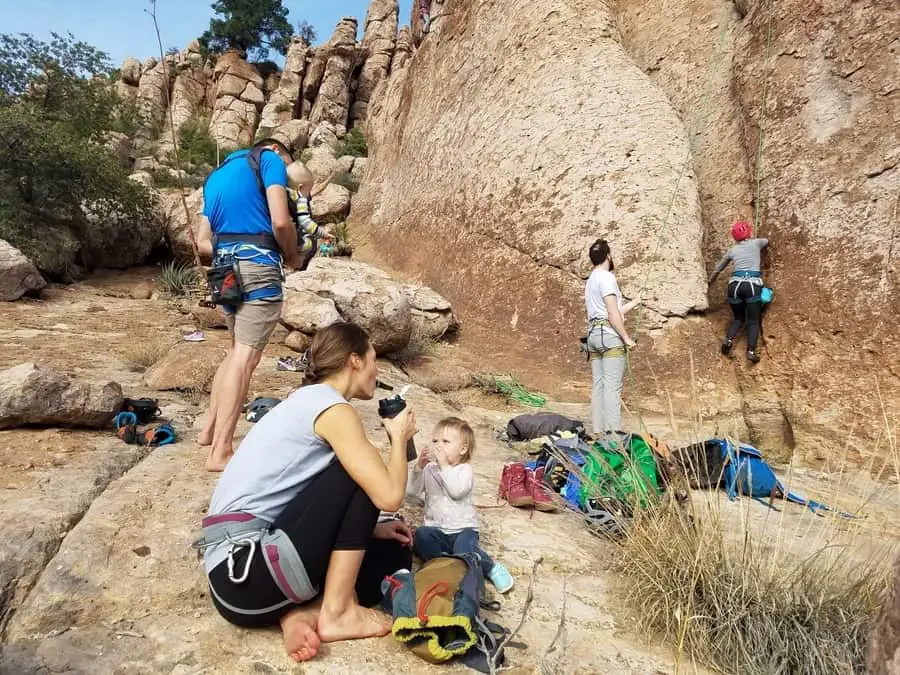
Don’t Go Alone
“Hey mom, watch this!” is not a phrase that a climber or belayer wants to hear while they’re tied in together. A distracted belayer can be very dangerous for a climber, so it’s important to always have someone else watching the kids.
I’m always a little hesitant to invite people to come climbing with us because it’s sort of like asking for a babysitter. Most people enjoy the entertainment between routes or problems though, and it’s always been a lot of fun.
The best scenario is to find another family or two that enjoys climbing and to go with them. You definitely won’t climb as many routes as you would by yourselves, but this way you can focus on the wall and forget about all of the wonderful distractions at the bottom.
Having 3 people is the minimum, but 4 is nice to be able to have two adults hanging out instead of one person off chasing the kids. A group of 5, with 2 pairs climbing and one person watching the kids is great. Decide ahead of time that the person or people watching the kids have the sole responsibility for that while the others focus on climbing.
Once kids are old enough to climb themselves, it’s still good to have an extra person around just in case of emergency. You never know when a kid will get scared and freeze up on the wall and it’s good to have someone who can go up and get them.
Lower your Expectations
Sure, a 10 year old girl has climbed El Cap, but your kid probably won’t. In general, the parents who force their kids to adopt their hobbies end up being the parents whose kids just aren’t into it. Positive encouragement is extremely important, but bullying and fear won’t get you anywhere. If they want to come down, let them down!
has climbed El Cap, but your kid probably won’t. In general, the parents who force their kids to adopt their hobbies end up being the parents whose kids just aren’t into it. Positive encouragement is extremely important, but bullying and fear won’t get you anywhere. If they want to come down, let them down!
Give lots of tips while they’re climbing, and keep the encouragement flowing. Point out good holds for them, and don’t be afraid to throw your weight into the belay in order to help them through a difficult section. At a young age (at any age) the most important thing is for them to have fun.
Your days of waking up at the crack of dawn and climbing all day until your arms fall off are probably over- at least if you bring your kids. Be prepared to get a route in and call it a day if necessary. If you start out with really low expectations, you won’t be disappointed. Take the time to enjoy being outside with your family.

Pack enough Toys, Snacks, (and Diapers!)
Nothing extends a kid’s attention span like a good snack. Bring along plenty of snacks and fun toys to keep the kids occupied while you climb. Make sure you have enough of the other essentials like wipes and diapers as well.
We always try to bring enough for as long as we hope to stay at the crag and use them up as fast as we need to. Toys are fun, but rocks and quickdraws are fun too-great for teething!
Stick to Single Pitch or Bouldering
Multi-pitch climbing is pretty much out, up to about age 10 (at the youngest). It’s not a lot of fun to watch someone’s kids while they climb up a 3-pitch tower, so don’t make anyone do that for you.
Short routes and boulder problems are the best because you can cycle through pretty quickly and still get a pretty good day in. The kids enjoy having a different adult to play with every twenty minutes or so as well.
Bouldering is the best way for kids to start out since they don’t have to worry much about their innate fear of heights. It’s easy for a parent to spot them, and easy to help them down whenever they’re done. Additionally, you really don’t need any extra gear for the kids to start out.
When you go bouldering, set clear rules for the kids to stay out from underneath the person bouldering. They usually want to play on the pad, but this can be really dangerous if someone falls on them. Kids of any age can take turns playing on the pad, as well as bouldering.
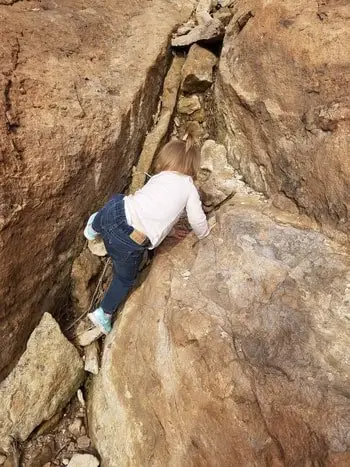
Have a Backup Plan
Some days climbing just isn’t going to work. Be content with just enjoying the time away from your regular life, and just relax. It’s always good to have a backup plan for a climbing trip, whether that means throwing your kid in a backpack and going for a hike instead or stopping for ice cream on the way home.
Come up with a backup plan ahead of time so that you still have something to look forward to if it all crashes and burns. For us this usually means going on a little hike in the vicinity instead of climbing.
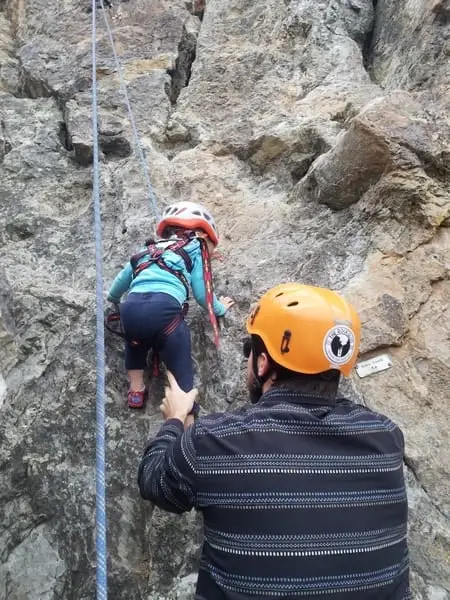
Get the Right Climbing Gear for Kids
I learned to climb in a harness that my dad tied out of webbing. He also made his own harness out of old seatbelts he sewed on his mom’s sewing machine. Thank goodness this isn’t the 1970’s anymore.
There is a ton of gear out there that is made specifically for kids, designed to fit them well and keep them safe. Kids should be in a full body harness until they are at least around 80 lbs (~7 years old). Each manufacturer has slightly different recommendations, so double check with them before you use anything.
A full body harness ensures the kid doesn’t fall out in case she or he flips upside down. Because kids have such small hips, it can be dangerous to just use a regular waist harness.
There are two main styles of kid’s harnesses, either a single piece full body harness like the Trango Junior (view price on Amazon ) or a 2-piece harness like the Petzl Macchu Body Harness (view price on Amazon
) or a 2-piece harness like the Petzl Macchu Body Harness (view price on Amazon ). The nice thing about the 2-piece chest harness is that it can be used as a regular harness as they grow up.
). The nice thing about the 2-piece chest harness is that it can be used as a regular harness as they grow up.
The other specific climbing gear that kids need is a helmet. Kids usually hate helmets, or really anything restrictive, so set an example by wearing one yourself (you should do this anyway).
Something like the Edelrid Shield II (view price on Amazon ) specifically designed for climbing is best, but at least have them wear a bike helmet. Depending on how much your kids get into climbing, you can get climbing shoes for them as well (if this is you, try out the La Sportiva Stickit shoes
) specifically designed for climbing is best, but at least have them wear a bike helmet. Depending on how much your kids get into climbing, you can get climbing shoes for them as well (if this is you, try out the La Sportiva Stickit shoes ).
).
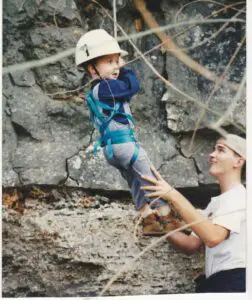
Be Prepared for Anything
We all have stories of some sort of suffer-fest when an unseen storm rolled in, or we got lost on the way out, or we had to rappel out in the dark without flashlights. Those can be fun stories to share after the fact, but they really can’t happen with kids or a baby in tow. Check the weather before you go, and err on the side of caution if the weather starts to turn.
Don’t try to squeeze that last lead in as it starts to get dark, and bring a headlamp or two anyway. Accidents do happen on occasion as well, so make sure you have a first aid kit (with Disney-themed band-aids). Be prepared for the heat or the cold, and stay out of the sun.
Temper your Personal Ambitions
This can be the hardest thing for new parents. Having really high ambitions can mean putting your kids at risk. Know that you won’t be able to get out as often, stay as long, or go as hard as you used to. I struggled with this for a while, frustrated that I couldn’t get out as often as I wanted and that I wasn’t improving, until one day everything changed.
I was about halfway up a sport route with a friend belaying while my wife played with our 18-month old. Suddenly I heard some babbling mixed with ‘dada! dada!’ I had my own little fan club at the bottom, and they didn’t care what grade I was climbing or how many laps I did that day.
Of course I still have goals and ambitions, but this helped me to keep everything in perspective. At the end of the day, climbing is about having fun and being outside. It’s great that I can do that with the people I care about most.
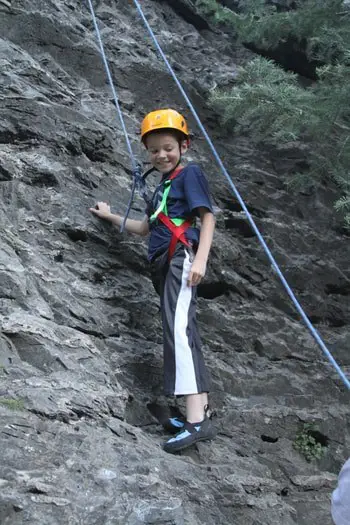
Tips for climbing with a baby
Most of the tips above apply to babies as well, except that you need to exercise more caution, more patience, and lower expectations even further. Here are some other tips that can help get you outside with even a young baby.
- Have a plan for naptime. Some kids will sleep in your arms, some will sleep in a hammock, and some will sleep on a blanket or in a pack ‘n’ play. Ours needed it to be pitch-black in order to sleep, so we didn’t have much luck with this after about 6 months old. She did sleep in camping chairs when she was tiny.
- Bring plenty of food. Whether formula-feeding or breastfeeding, bring plenty of food for the baby and both food and water for the mom. The baby will stay hydrated by eating more.
- Set up a safe play area away from the wall. In case of rockfall or in the case of a climber dropping gear the baby needs to be far enough away that he/she is safe.
- Stay out of the sun. Set up some sort of sun shade to keep the baby out of the sun. This can be a little pop up beach tent or a blanket rigged at an angle, but the last thing you want is a sunburned baby. They need some time to work up a base tan!
- Bring a baby carrier or backpack. If our daughter ever gets fussy while we’re climbing, the 3rd person usually just puts her in the backpack and goes for a little hike. She loves getting carried around (I can imagine I would too!) and it keeps her entertained or slowly rocks her to sleep.
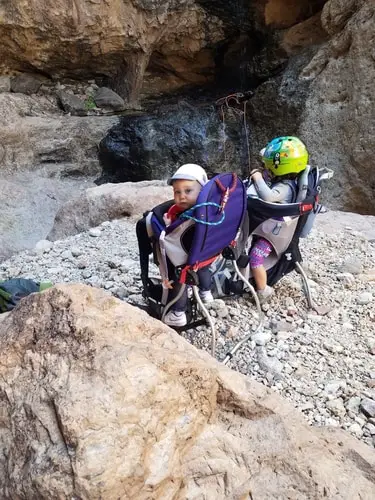
When should kids start climbing?
Kids can start the easiest forms of climbing and bouldering as early as they are crawling, but harnesses for kids have a lower limit of about 25 pounds or 2-3 years old. Most kids who start young begin at around 5 years old, and this is usually the age that gyms start offering courses to kids.
At this age they are able to climb to the top of the simplest routes and then lean back and trust the rope to lower them down, and they might even follow directions! Climbing helps children develop their coordination and motor skills, improve their balance, and learn that they are capable of doing hard things.
We built a small climbing wall for our daughter when she was 1 year old. She liked climbing up high enough to get her feet off the ground, and learned to look down to place her feet instead of just pulling with her hands. This really helped her balance and went along well with her stage of wanting to climb up everything.
It’s best for kids to start out bouldering. They can get the feel for the power of their bodies and learn how to climb without needing to try to overcome the fear of heights at the same time. Parents can keep one hand on their kids at low heights and help them get comfortable scrambling up big rocks and small walls.
For younger kids, even walking across the top of an uneven boulder can be challenging and exhilarating. They learn problem solving skills and learn to make precise, deliberate movements. They learn that by practicing they can quickly improve their talents.
Rock climbing teaches slightly different skills and strengths, and builds on many of those developed by bouldering. It teaches kids to rely on the belayer and the system for safety and to beat fear. It teaches them that they can overcome any challenge in front of them. For more information on what age kids should start climbing, see our post What Age Should Kids Start Climbing?
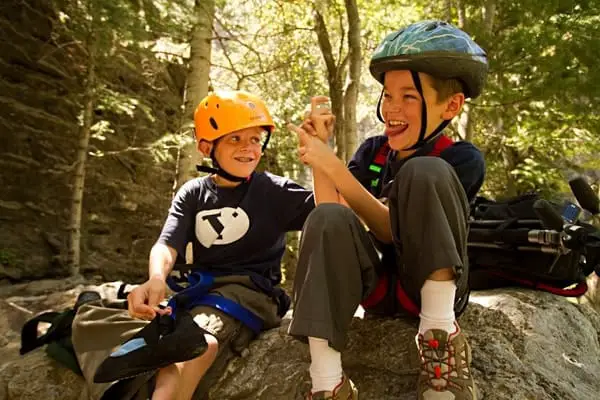
Related Questions:
Is Rock Climbing or Bouldering Better for Kids? Bouldering is certainly a lot easier to start out because it requires no gear and little technical expertise. Kids can learn how to use different kinds of handholds and how to position their feet while bouldering, and then make the transition to rock climbing if they choose.
Is Rock Climbing a Safe Activity for Kids? Rock climbing, when practiced correctly, can be a very safe and exciting activity for kids. The main risks involved are human caused, such as incorrect knots or a lapse in attention. For more information, read our article: Is Indoor Rock Climbing Dangerous?
See Also:
Is Indoor Rock Climbing a Good Workout?

